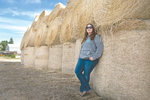Clear, 75° F
There’s something familiar about Sara Wood’s dream. She already had the majestic purple mountain with deer and antelope. Now she’s adding waves of ancient grains.
In her dream, …
This item is available in full to subscribers.
The Powell Tribune has expanded its online content. To continue reading, you will need to either log in to your subscriber account, or purchase a subscription.
If you are a current print subscriber, you can set up a free web account by clicking here.
If you already have a web account, but need to reset it, you can do so by clicking here.
If you would like to purchase a subscription click here.
Please log in to continue |
|





There’s something familiar about Sara Wood’s dream. She already had the majestic purple mountain with deer and antelope. Now she’s adding waves of ancient grains.
In her dream, Wood can see species like einkorn and red fife thriving in fields homesteaded by her forefathers. She longs for the days when every region had the distinct flavor of locally produced foods, when almost every town had a mill. Now there’s only one commercial flour mill in Wyoming — well, almost. Wood’s vision isn’t quite complete, but her mill and malthouse are taking shape northwest of Ralston.
Boiled down, Wood’s dream is essentially returning to a time when people knew the origin of their food.
The Big Horn Basin is perfect for growing barley. So Wood took it a step further by joining the Craft Malt Guild in 2014. Shortly after, she found making malt was more complex than anticipated and, through further studies, she found an art to the science. The art drew her in.
“It’s a piece that’s missing in our chain. Think about how many breweries that keep popping up and how many distilleries we have in Wyoming,” she said.
Over the past eight years, Wood essentially has given herself a master’s course on botany, chemistry and business administration — working tirelessly to develop an expertise on ancient grains, the malting process and pinching pennies. It’s required more than $1 million to make her dream come true. That’s 100 million pinches.
Those who farm know there are few free minutes in the day. Yet Wood kept her dream alive while both she and her husband, Pat, held down full-time jobs, worked the family land at Wooden Shoe Farms and raised two energetic children.
Then there was bureaucracy. Making malts and flours was once taken for granted, but fast forward a few generations and starting a mill requires special permission from the county government.
“Planning and zoning was intimidating,” Wood said. “Our county wants diversification, but it’s really hard to get any sort of special use permits.”
Many with half of Wood’s challenges have allowed their dreams to fade, but she wouldn’t give up.
After a months-long process, Park County commissioners unanimously approved a special use permit for Wyoming High Desert Malt on Aug. 20. That formally gave the value-added agricultural business permission to start milling wheat and making malt.
“I think it’s neat to see entrepreneurs, especially in the ag-related industries,” said Commission Chairman Jake Fulkerson. “I think it’s great. I mean, this is how it starts. ... That’s how we create jobs right here in our hometown.”
Wood said she appreciated the help provided by Christine Bekes at Powell Economic Partnership with financing, networking and in navigating the county’s process.
Now, realizing her dream is just a matter of putting the finishing touches on the million-dollar facility, passing USDA state inspections and growing grains that haven’t been harvested in the Basin for generations.
Fortunately, finding customers shouldn’t be an issue. She has a list of potential customers rooting for her — almost everyone into baking or beer.
“It has potential to be a cool thing for this area,” said Chris Cox, an ag lender at First Bank of Powell, co-founder of WYOld West Brewing Co. and founder of Heart Mountain Hopheads, a local home brewing organization.
Briess Malt and Ingredients Co., which owns and operates the large barley elevator outside of Ralston, is a household name in the home brewer world, Cox said.
“It has always been kind of cool for us to have the ability to buy Briess products that were possibly grown in the area,” Cox said. “I’ve asked a few Briess guys where the crops grown around here end up, but you can’t really find out if you’re buying a Powell or [Big Horn] Basin product despite the connection here.”
However, if Wood’s Wyoming High Desert Malt produces malts for home brewers, “I would use her products exclusively if at all possible,” Cox said, “because I’d much prefer to have a product that’s grown and produced here.”
Not only is Wooden Shoe Farms experienced in growing malt barley, Pat and Sara are fans of craft beer. Pat likes dark beers and Sara enjoys occasional red ales and amber style Oktoberfest brews. Like most producers in the area, they’ve been selling their harvested crops to large beer companies. “We’ve had Coors, Budweiser and now Briess. So I started looking into malt and what malt was,” Wood said. “Then I thought, why don’t we do that?”
But it took some convincing. Her husband and dad weren’t on board at first. “I started really pushing about three years ago,” she said. “We looked into it and they started to believe me.”
They grew barley and red spring wheat last year. White Sonora wheat, brought here by explorer Francisco Coronado in the 1500s, is on her list for next spring, along with several other varieties of grain. Ancient grains were lost as growers went for hybrid grains with higher yields, lower proteins and better sugar content. The use of modified grains pushed the gluten content up. “Some people say it’s 80 percent higher than it used to be,” Wood said.
But now there’s renewed interest in going back to older types of grains and locally sourced foods.
Last week, the entire family worked to build heated floors in the production facility, which will be used for a traditional floor malting process. After steeping, wet grain is moved to the smooth, heated concrete floor while it germinates. Over the course of four or five days, the grains germinate and produce sugars, later fermented into alcohol. The malt facility will take up about half the space of an existing 5,000 square foot shop, located on Emery Road, and south of Lane 11.
Even the couple’s children, Flint and Scarlett, tried their tiny hands at zip-tying heating tubes to forms last week. Wood’s dream has become her entire family’s — and soon they and future customers will taste the fruits of their labor.